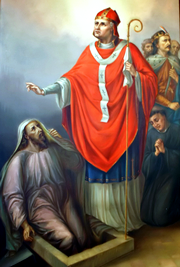
Saint Stanislaus
Feast May 7th
Bishop of Kraków, Martyr (1030-1079)
Saint Stanislaus was born at Szczepanów, a village in Lesser Poland, in answer to the prayer of his noble and pious parents, Wielisław and Bogna, who were advanced in age. Out of gratitude they prepared him for the priesthood at a cathedral school in Gniezno (then the capital of Poland) and later, according to some sources, in Paris or Liège. When his parents died, he sold their vast properties and gave the money to the poor. On his return to Poland, Stanisław was ordained a priest by Lambert II Suła, Bishop of Kraków, and being a holy priest, soon afterwards became a Canon of the Kraków cathedral.
After the Bishop’s death (1072), Stanisław was elected his successor but accepted the office only at the explicit command of Pope Alexander II. Stanisław was one of the earliest native Polish bishops. Saint Stanislaus donned a hair shirt, which he wore until he died. He had a list drawn up of every poor person of the city, and gave orders to his servants never to refuse anything to anyone.
Boleslaus II was at that time King of Poland; he was a prince of good disposition, but spoilt by a long series of victories and successes. After many acts of lust and cruelty, he outraged the whole kingdom by carrying off the wife of one of his nobles. Against this public scandal the chaste and gentle bishop alone raised his voice. Having commended the matter to God, he went to the palace and openly rebuked the king for his crime against God and his subjects, and threatened to excommunicate him if he persisted in his sin. Boleslaus, with the intention of irrevocably ruining the bishop’s good reputation, suborned the nephews of a man named Paul who had recently died, to swear that their uncle had never been paid for land which the bishop had bought for the Church. Saint Stanislaus stood fearlessly before the king’s tribunal, though all his frightened witnesses forsook him, and guaranteed to bring the dead man to witness in his favor within three days.
On the third day, after many prayers and tears, he raised the dead man to life and led him in his grave-clothes before the king, where Paul testified that the bishop had reimbursed him fully for the terrain he had sold. He was then taken back to the grave, where he lay down and again relapsed into his former state, before a large number of witnesses.
Boleslaus for a while made a show of a better life. Soon, however, he returned to the most scandalous excesses, and the bishop, finding all remonstrance useless, pronounced the sentence of excommunication. In defiance of the censure, on May 8, 1079, the king went to a chapel where Saint Stanislaus was saying Mass and commanded three groups of soldiers in succession to slay him at the altar. Each in turn came out, saying he had been alarmed by a light from heaven. At this the king himself rushed in and slew with his own hand the Saint at the altar during the Holy Sacrifice. The guards then cut the Bishop’s body into pieces and scattered them to be devoured by wild beasts. According to the legend, his members miraculously reintegrated while being guarded by four eagles.
The Pope placed the kingdom of Poland under interdict, excommunicated the king and declared his royalty null and void. Boleslaus repented, took refuge in another country for a time, then set out dressed as a pilgrim for Rome. On the way he knocked on a monastery door to ask for an alms, then decided to enter there anonymously, and was received. He spent seven years there as a Benedictine lay brother, rendering every humble service to the monks, patiently bearing rude treatment. Only on his deathbed did he identify himself, taking out his royal ring which he had concealed until then. He had spent hours praying before a statue of Our Lady in the chapel, by which we may conclude that the Mother of God had obtained for him the grace of conversion and a happy death. His body remains in the church of the same monastery of Ossiach.
Saint Stanislaus was canonized by Pope Innocent IV in 1253.
References and Excerpts
[1] “Lives of the Saints, Saint Stanislaus,” 24 February 2016. [Online]. Available: http://sanctoral.com/en/saints/saint_stanislaus.html. [Accessed 30 April 2016].
[2] M. P. Guerin, Les Petits Bollandistes: Vies des Saints, Paris: Bloud et Barral, 1882.
[3] J. G. Shea, Little Pictorial Lives of the Saints, New York: Benziger Brothers, 1894.
[4] “Stanislaus of Szczepanów,” Wikipedia The Free Encyclopedia, [Online]. Available: https://en.wikipedia.org/wiki/Stanislaus_of_Szczepanów. [Accessed 30 April 2016].